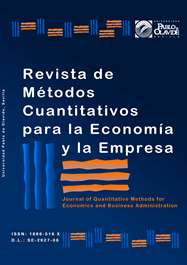Pricing Loss Index Triggered Cat Bonds. An Ornstein-Uhlenbeck Process-Based Model
DOI:
https://doi.org/10.46661/revmetodoscuanteconempresa.2891Keywords:
bonos sobre catástrofes, cuantía de siniestros pendiente de declarar, cuantía declarada de siniestros, tasa de declaración de siniestros, índice de pérdidas por catástrofes, proceso de Ornstein-UhlenbeckAbstract
This paper develops a continuous-time random model of loss index triggers for cat bonds on the basis of the loss amount incurred until their maturity. Assuming that total loss amount due to a catastrophe is defined as the sum of the incurred loss amount plus the incurred-but-not-yet reported loss amount, we model the decreasing linear dynamics of the latter amount by means of an additive Brownian process (or Ornstein Uhlenbeck process); and get the former by the difference between the total loss amount and the incurred-but-not-yet-reported loss amount. Finally, we test the validity of the model by estimating its core parameters and by contrasting the goodness of fit through a data series of six floods occurred in several Spanish cities prone to suffer such kind of catastrophes.
Downloads
References
Aase, K. (1999): “An Equilibrium Model of Catastrophe Insurance Futures and Spreads”. Geneva Papers on Risk and Insurance Theory, 24, 69-96.
Aase, K. (2001): “A Markov model for the pricing of catastrophe insurance futures and spreads”. Journal of Risk and Insurance, 68 (1), 25-50.
Alegre, A.; Pérez-Fructuoso, M.J. & Devolder, P. (2003): “Modèles discrets d'options sur risques catastrophiques”. Belgian Actuarial Bulletin, 3, 28-32.
Arnold, L. (1974): Stochastic Differential Equations: Theory and Applications. New York: John Wiley & Sons.
Cummins, J.D. & Geman, H. (1995): “Pricing Catastrophe Insurance Futures and Call Spreads: An Arbitrage Approach”. Journal of Fixed Income, 4, 46-57.
Cox, S.H. & Pedersen, H. (2000): “Catastrophe Risk Bonds”. North American Actuarial Journal, 4(4), 56-82.
Embrechts, P. & Meister, S. (1997): “Pricing insurance derivatives, the case of CAT futures”. En H. Bühlmann (ed.): Securitization of Insurance Risk: The 1995 Bowles Symposium. SOA Monograph M-FI97-1. Schaumburg: Society of Actuaries, pp. 15-26.
Geman, H. & Yor, M. (1997): “Stochastic time changes in catastrophe option pricing”. Insurance: Mathematics and Economics, 21, 185-193.
Johnson, N.L., Kotz, S. & Balakrishnan, N. (1994): Continuous Univariate Distributions, Volume 1. New York: John Wiley & Sons.
Lee, J.P. & Yu, M.T. (2002): “Pricing default-risky Cat bonds with moral hazard and basis risk”. Journal of Risk and Insurance, 69 (1), 25-44.
Loubergé, H.; Kellezi E. & Gilli, M. (1999): “Using Catastrophe-Linked Securities to Diversify Insurance Risk: A Financial Analysis of Cat Bonds”. Journal of Insurance Issues, 22 (2), 125-146.
Muermann, A. (2003): “Actuarially Consistent Valuation of Catastrophe Derivatives”. The Wharton Financial Institutions Center Working Paper Series, 03-18, 21 pp. Recuperado de http://citeseerx.ist.psu.edu/viewdoc/download?doi=10.1.1.201.6584&rep=rep1&type=pdf.
Nowak, P. & Romaniuk, M. (2013): “Princing and simulations of catastrophe Bonds”. Insurance: Mathematics and Economics, 52, 18-28.
Pérez-Fructuoso, M.J. (2009): “Elaborating a catastrophic loss index for insurance-linked securities (ILS) a continuous model”. Asian-Pacific Journal of Risk and Insurance, 3(2), 34-45.
Pérez-Fructuoso, M.J. (2008): “Modeling loss index trigger for Cat bonds: A continuous approach”. Variance, 2(2), 253-265.
Zong-Gang, M. & Chao-Qun, M. (2013): “Princing catastrophe risk Bonds: a mixed approximation method”. Insurance: Mathematics and Economics, 52, 243-254.
Downloads
Published
How to Cite
Issue
Section
License
Copyright (c) 2017 Journal of Quantitative Methods for Economics and Business Administration

This work is licensed under a Creative Commons Attribution-ShareAlike 4.0 International License.
Submission of manuscripts implies that the work described has not been published before (except in the form of an abstract or as part of thesis), that it is not under consideration for publication elsewhere and that, in case of acceptance, the authors agree to automatic transfer of the copyright to the Journal for its publication and dissemination. Authors retain the authors' right to use and share the article according to a personal or instutional use or scholarly sharing purposes; in addition, they retain patent, trademark and other intellectual property rights (including research data).
All the articles are published in the Journal under the Creative Commons license CC-BY-SA (Attribution-ShareAlike). It is allowed a commercial use of the work (always including the author attribution) and other derivative works, which must be released under the same license as the original work.
Up to Volume 21, this Journal has been licensing the articles under the Creative Commons license CC-BY-SA 3.0 ES. Starting from Volume 22, the Creative Commons license CC-BY-SA 4.0 is used.










